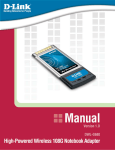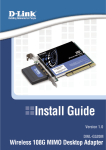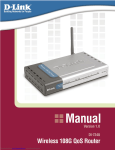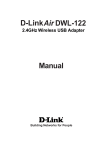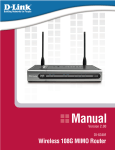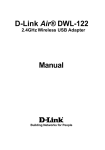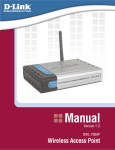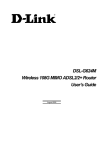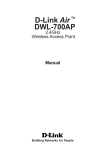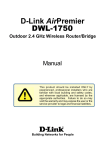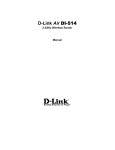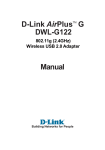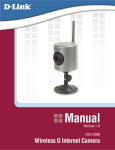Download D-Link (DWL-G520M) 802.11g/b (DWLG520M) Wireless Adapter
Transcript
DWL-G520M User’s Manual Table of Contents Table of Contents Table of Contents ............................................................................................... 2 Package Contents .............................................................................................. 3 Introduction ....................................................................................................... 4 Features and Benefits ......................................................................................... 5 Wireless Basics .................................................................................................. 6 Installation Considerations ................................................................................. 8 Getting Started ................................................................................................... 9 Using the Configuration Utility ......................................................................... 12 Link Info..................................................................................................... 13 Configuration ............................................................................................. 14 Encryption.................................................................................................. 15 Site Survey................................................................................................. 17 Networking Basics ........................................................................................... 21 Troubleshooting ............................................................................................... 34 Technical Specifications ................................................................................... 37 Glossary ........................................................................................................... 39 Contacting Technical Support ........................................................................ 40 Warranty .......................................................................................................... 41 Registration ..................................................................................................... 45 D-Link Systems, Inc. 2 DWL-G520M User’s Manual Package Contents Package Contents D-Link DWL-G520M 108G MIMO Wireless Desktop Adapter Manual on CD Printed Quick Installation Guide If any of the above items are missing, please contact your reseller. Minimum System Requirements A desktop computer with an available 32-bit PCI slot Windows XP/2000 At least 64MB of memory and a 500MHz processor An 802.11g or 802.11b access point (for Infrastructure mode), or another 802.11g or 802.11b wireless adapter (for Ad-Hoc, Peer-to-Peer networking mode.) D-Link Systems, Inc. 3 DWL-G520M User’s Manual Introduction Introduction Connect to wireless networks at farther distances than before with D-Link AirPlus Xtreme G™ line of products infused with Double XR (2XR) Technology. By combining D-Link’s new 2XR technology with D-Link 108G technology, this new Wireless Desktop Adapter offers dramatic performance improvements over standard 802.11g. Based on the latest in Smart Antenna technology, 2XR technology provides the DWL-G520M Wireless 108G MIMO Desktop Adapter with the performance boost which delivers Xccelerated Rates at Xtended Range. When paired with D-Link’s 2XR-powered Wireless 108G MIMO Router for an end-to-end solution, obtain up to 8x faster speeds at 8x farther coverage. Have more flexibility in the placement of your desktop and still maintain a strong wireless connection. Even if only your client adapter is 2XR-enabled, you can still experience the performance benefits of faster rates at father distances with virtually any standard 802.11g wireless router. In addition, the DWL-G520M remains backward compatible to 802.11b. As an end-to-end 2XR solution, or even as a single-ended solution, D-Link’s 2XR technology is capable of providing exceptional wireless performance while dramatically reducing the number of dead spots throughout your home or office. With an included configuration utility and the Installation Wizard, setup for your DWL-G520M is a straightforward process. The utility keeps track of your most frequently accessed networks and their specific settings, so joining networks is an automatic process. The DWL-G520M also supports the latest security features such as WPA-PSK making your adapter compatible with secure wireless networks. * Maximum wireless signal rate derived from IEEE Standard 802.11g specifications. Actual data throughput will vary. Network conditions and environmental factors, including volume of network traffic, building materials and construction, and network overhead lower actual data throughput rate. D-Link Systems, Inc. 4 DWL-G520M User’s Manual Features and Benefits Features and Benefits Enable 802.11g Wireless Connectivity on Your Desktop PC Enable wireless connectivity on your desktop computer with the DWL-G520M. With the performance of D-Link’s new line of Smart Antenna MIMO wireless products, the DWL-G520M delivers an unsurpassed wireless experience by boosting both speed and signal coverage. Be able to place your desktop at farther distance from your router or access point. Perform multiple network tasks at once with the speed provided by this Wireless Desktop Adapter. Enhanced Wireless Performance with Double XR (2XR) Technology Based on Smart Antenna MIMO Technology, D-Link’s new Double XR (2XR) Technology significantly improves network performance. Designed to deliver Xccelerated Rates at an Xtended Range, use this Desktop Adapter with D-Link’s Wireless 108G MIMO Router for the total performance benefits of up to 8x faster speeds and 8x better coverage*. Complete Support for WPA Support for the latest wireless security technologies ensures that your wireless connection is safe and secure via WPA-PSK. The DWL-G520M makes the process of establishing a connection to a protected network a straightforward process. Quickly Join and Rejoin Networks with the D-Link Utility The D-Link Utility can quickly discover available wireless networks, and simplify the process of joining a network. The D-Link Utility will also keep track of your most frequently used networks to make rejoining a network quicker without reentering the network information. Backward Compatible to Both Standard 802.11g and 802.11b Networks You don’t have to replace any existing network hardware in order to work with the DWL-G520M. Fully backward compatible to 802.11g and 802.11b, you can communicate with your existing wireless devices and still experience performance enhancements with just this 2XR-powered desktop adapter. * Maximum wireless signal rate derived from IEEE Standard 802.11g specifications. Actual data throughput will vary. Network conditions and environmental factors, including volume of network traffic, building materials and construction, and network overhead lower actual data throughput rate. D-Link Systems, Inc. 5 DWL-G520M User’s Manual Wireless Basics Wireless Basics D-Link wireless products are based on industry standards to provide easy-to-use and compatible high-speed wireless connectivity within your home, business or public access wireless networks. D-Link wireless products will allow you access to the data you want, when and where you want it. You will be able to enjoy the freedom that wireless networking brings. A wireless local area network (WLAN) is a computer network that transmits and receives data with radio signals instead of wires. WLANs are used increasingly in both home and office environments, and public areas such as airports, coffee shops and universities. Innovative ways to utilize WLAN technology are helping people to work and communicate more efficiently. Increased mobility and the absence of cabling and other fixed infrastructure have proven to be beneficial to many users. Wireless users can use the same applications they use on a wired network. Wireless adapter cards used on laptop and desktop systems support the same protocols as Ethernet adapter cards. People use WLAN technology for many different purposes: Mobility - Productivity increases when people have access to data in any location within the operating range of the WLAN. Management decisions based on real-time information can significantly improve worker efficiency. Low Implementation Costs - WLANs are easy to set up, manage, change and relocate. Networks that frequently change can benefit from WLANs ease of implementation. WLANs can operate in locations where installation of wiring may be impractical. Installation and Network Expansion - Installing a WLAN system can be fast and easy and can eliminate the need to pull cable through walls and ceilings. Wireless technology allows the network to go where wires cannot go - even outside the home or office. Inexpensive Solution - Wireless network devices are as competitively priced as conventional Ethernet network devices. Scalability - WLANs can be configured in a variety of ways to meet the needs of specific applications and installations. Configurations are easily changed and range from Peer-to-Peer networks suitable for a small number of users to larger Infrastructure networks to accommodate hundreds or thousands of users, depending on the number of wireless devices deployed. D-Link Systems, Inc. 6 DWL-G520M User’s Manual Wireless Basics Standards-Based Technology The DWL-G520M Wireless PCI Adapter utilizes the 802.11g standard. The IEEE 802.11g standard is an extension of the 802.11b standard. It increases the data rate up to 54Mbps within the 2.4GHz band, utilizing OFDM technology. This means that in most environments, within the specified range of this device, you will be able to transfer large files quickly or even watch a movie in MPEG format over your network without noticeable delays. This technology works by transmitting high-speed digital data over a radio wave utilizing OFDM (Orthogonal Frequency Division Multiplexing) technology. OFDM works by splitting the radio signal into multiple smaller sub-signals that are then transmitted simultaneously at different frequencies to the receiver. OFDM reduces the amount of crosstalk (interference) in signal transmissions. The D-Link DWL-G520M will automatically sense the best possible connection speed to ensure the greatest speed and range possible. 802.11g offers the most advanced network security features available today, including: WPA, 802.1x, TKIP, AES and Pre-Shared Key (PSK) mode. The DWL-G520M is backwards compatible with 802.11b devices. This means that if you have an existing 802.11b network, the devices in that network will be compatible with 802.11g devices at speeds up to 11Mbps in the 2.4GHz range. Also based on the IEEE 802.11b standard, the DWL-G520M is interoperable with existing compatible 2.4GHz wireless technology with data transfer speeds of up to 11Mbps. D-Link Systems, Inc. 7 DWL-G520M User’s Manual Installation Considerations Installation Considerations The DWL-G520M lets you access your network using a wireless connection from virtually anywhere within its operating range. Keep in mind, however, that the number, thickness and location of walls, ceilings, or other objects that the wireless signals must pass through, may limit the range. Typical ranges vary depending on the types of materials and background RF (radio frequency) noise in your home or business. The key to maximizing wireless range is to follow these basic guidelines: Keep the number of walls and ceilings between the DWL-G520M and other network devices to a minimum - each wall or ceiling can reduce your adapter’s range from 3-90 feet (1-30 meters.) Position your devices so that the number of walls or ceilings is minimized. Be aware of the direct line between network devices. A wall that is 1.5 feet thick (.5 meters), at a 45-degree angle appears to be almost 3 feet (1 meter) thick. At a 2-degree angle it looks over 42 feet (14 meters) thick! Position devices so that the signal will travel straight through a wall or ceiling (instead of at an angle) for better reception. Building Materials make a difference. A solid metal door or aluminum studs may have a negative effect on range. Try to position access points, wireless routers, and computers so that the signal passes through drywall or open doorways. Materials and objects such as glass, steel, metal, walls with insulation, water (fish tanks), mirrors, file cabinets, brick, and concrete will degrade your wireless signal. Keep your product away (at least 3-6 feet or 1-2 meters) from electrical devices or appliances that generate RF noise. If you are using 2.4GHz cordless phones or X-10 (wireless products such as ceiling fans, lights, and home security systems), your wireless connection may degrade dramatically or drop completely. Make sure your 2.4GHz phone base is as far away from your wireless devices as possible. The base transmits a signal even if the phone in not in use. D-Link Systems, Inc. 8 DWL-G520M User’s Manual Getting Started Getting Started There are basically two modes of networking: Infrastructure – using an access point or router, such as the DI-624M. Ad-Hoc – directly connecting to another computer, for Peer-to-Peer communication, using wireless network adapters on each computer, such as two or more DWL-G520M Wireless Network adapters. On the following pages we will show you an example of an Infrastructure Network and an Ad-Hoc Network. An Infrastructure network contains an access point or router. The Infrastructure network example shown on the following page contains the following D-Link network devices (your existing network may be comprised of other devices): A wireless router - D-Link 108G MIMO DI-634M Desktop computers with a D-Link 108G MIMO DWL-G520M A cable modem - D-Link DCM-202 D-Link Systems, Inc. 9 DWL-G520M User’s Manual Infrastructure Network Setting up a Wireless Infrastructure Network For a typical wireless setup at home, please do the following: 1 You will need broadband Internet access (a cable or DSL-subscriber line into your home or office). 2 Consult with your cable or DSL provider for proper installation of the modem. 3 Connect the cable or DSL modem to your broadband router. (See the Quick Installation Guide included with your router.) 4 Install the D-Link DWL-G520M 108G MIMO Wireless Desktop Adapter into an available PCI slot on your desktop computer. (See the Quick Installation Guide included with the DWL-G520M.) 5 Install another D-Link DWL-G520M 108G MIMO Wireless Desktop Adapter into an available PCI slot on your desktop computer. (See the Quick Installation Guide included with the DWL-G520M.) D-Link Systems, Inc. 10 Ad Hoc Network DWL-G520M User’s Manual Setting up a Wireless Ad-Hoc Network 1 2 DWL-G520M 108G MIMO Wireless Desktop Adapter DWL-G650M 108G MIMO Wireless Notebook Adapter For a typical wireless setup at home (as shown above), please do the following: 1 Install the D-Link DWL-G520M 108G MIMO Wireless Desktop adapter into the desktop computer. (See the Quick Installation Guide included with the product.) 2 Install the D-Link DWL-G650M 108G MIMO Wireless Notebook adapter into the laptop computer or another DWL-G520 in a desktop computer. (See the Quick Installation Guide included with the product.) 3 Set the wireless configuration for the adapters to Ad-Hoc mode, set the adapters to the same channel, and assign an IP address to each computer on the Ad-Hoc network. IP Address When assigning IP addresses to the computers on the network, please remember that the IP address for each computer must be in the same IP address range as all the computers in the network, and the subnet mask must be exactly the same for all the computers in the network. For example: If the first computer is assigned an IP address of 192.168.0.2 with a subnet mask of 255.255.255.0, then the second computer can be assigned an IP address of 192.168.0.3 with a subnet mask of 255.255.255.0, etc. IMPORTANT: If computers or other devices are assigned the same IP address, one or more of the devices may not be visible on the network. D-Link Systems, Inc. 11 DWL-G520M User’s Manual Using the Configuration Utility Using the Configuration Utility D-Link DWL-G520M 108G MIMO Wireless Desktop adapter uses the Configuration Utility as the management software. The utility provides the user an easy interface to change any settings related to the wireless adapter. After you have completed the installation of the DWL-G520M (refer to the Quick Installation Guide that came with your purchase) whenever you start the computer, the Configuration Utility starts automatically and the system tray icon is loaded in the toolbar (see illustration below*). Clicking on the utility icon will start the Configuration Utility. Another way to start the Configuration Utility is to click on Start > Programs > D-Link Technology > D-Link Wireless Utility. If you are using Windows XP, you can use either the Zero Configuration Utility or the D-Link Configuration Utility. To use the D-Link Configuration Utility with XP, right-click on the wireless network icon in the taskbar in the lower right-hand corner of your computer screen. In the window that appears, select View Available Wireless Networks and click the Advanced button. The screen at right will appear. Select the Wireless Networks tab. Uncheck the box in the properties window that enables windows configuration. After you have done this, you can then use the D-Link Configuration Utility with XP by clicking on the D-Link Configuration Utility icon. *Configuration Utility icon in the system tray If the icon does not display in the taskbar, then click on this icon on your desktop to open. D-Link Systems, Inc. 12 DWL-G520M User’s Manual Using the Configuration Utility Link Info Status: Displays the MAC address of the access point or router to which the DWL-G520M is associated. SSID: The Service Set Identifier is the name assigned to the wireless network. The factory SSID setting is default. Tx Rate: The default setting is Auto; Tx Rate settings are automatically determined for a maximum wireless signal rate of up to 54Mbps (108Mbps* in Turbo mode). Channel: The default setting is Auto. The channel selection is automatically determined by the DWL-G520M. Rescan: Rescans for the strongest signal with the current SSID and associates with that access point or router. Link Quality: Displays the Link Quality of the DWL-G520M’s wireless connection to the access point or router. Signal Strength: Displays the signal strength and the link quality of the DWL-G520M’s wireless connection to the access point or router Data Rate: Displays the statistics of the data packets that are transmitted and received. * Maximum wireless signal rate derived from IEEE Standard 802.11g specifications. Actual data throughput will vary. Network conditions and environmental factors, including volume of network traffic, building materials and construction, and network overhead lower actual data throughput rate. D-Link Systems, Inc. 13 DWL-G520M User’s Manual Using the Configuration Utility Configuration SSID (1-3): The Service Set Identifier is the name assigned to the wireless network. The factory SSID setting is default. You can enter up to 3 wireless networks to connect to. Wireless Mode: Select Infrastructure if you want to connect to an access point or wireless router. Ad-Hoc mode is used for peer-to-peer networking. Channel: The channel selection is automatically determined by the DWL-G520M. When in Ad-Hoc mode, you may select a channel manually. The default channel is 6. Ad-Hoc Band: Select 11G or 11B (see Support Band below). Power Mode: Continuous Access Mode is the default setting. For best results leave this setting at the default. Support Band: Select the wireless mode of your wireless network. 11G - Connect to an 802.11g only network. 11B - Connect to an 802.11b only network. Check both to connect to an 802.11b/g mixed network. D-Link Systems, Inc. 14 DWL-G520M User’s Manual Using the Configuration Utility Encryption Encryption: Select the Encryption mode here. The choices are: WEP, WPA-PSK or None. When WPA-PSK is selected, click Config and the pop-up windows, shown on the following pages, will appear on your screen. Auth. Mode: Choose one of the following modes: Open Authentication – the DWL-G520M is visible to all devices on the network. Shared Authentication – allows communication only with other devices with identical WEP settings. Auto – the DWL-G520M will automatically select the best Authentication mode for your network. Config: When you select WPA-PSK in the Auth. Mode pulldown menu, click Config. The popup windows shown on the following pages will appear. D-Link Systems, Inc. 15 DWL-G520M User’s Manual Using the Configuration Utility Encryption-WPA-PSK When you select WPA-PSK in the Encryption window, the screen below will appear. Suitable for the home user, WPA-PSK (WPA Pre-Shared Key) is a superior form of security that does not require a RADIUS server in the network. By using TKIP (Temporal Key Integrity Protocol), the security keys change at set intervals, creating a network that is more secure than one that utilizes WEP encryption alone. Define WPA PSK: Enter the WPA Passphrase. The key is an alpha-numeric password between 8 and 63 characters long. The password can include symbols (!?*&_) and spaces. All the devices on the network must share this same passphrase in order to communicate on the network. OK: Click OK to save the passphrase. *Hint: The longer the key, the more secure your network will be. D-Link Systems, Inc. 16 DWL-G520M User’s Manual Using the Configuration Utility Site Survey Available Network: The top section of the window displays the Available Networks. Scroll up and down the list and highlight the network to which you wish to connect. Click on the Connect button. Refresh: Click on Refresh to get the most updated list of available networks. Connect: Highlight a network profile and click Connect to connect to that network. Profile: In the lower half of the screen, you can manage the profiles that you have created. Scroll up and down and highlight the profile that you wish to configure. You can Add or Remove a profile, or configure the Properties of the profile in order to connect with an available network. Add: Click Add and the screen on the next page will appear. Remove: Highlight a network profile; click Remove to remove a network from the profile list. Properties: Click to configure properties on the popup screen on the next page. D-Link Systems, Inc. 17 DWL-G520M User’s Manual Using the Configuration Utility Site Survey - Profile Configuration When you click Add, Properties or Connect in the Site Survey screen, this popup screen appears for configuration purposes. Profile Name: Enter a name for the network profile here. SSID: The Service Set Identifier is the name assigned to the wireless network. The factory SSID setting is default. You may enter up to 3 SSIDs. Wireless Mode: Either Infrastructure or Ad-Hoc will be displayed here. (Please see the Getting Started section in this manual for an explanation of these two modes.) Channel: The channel selection is automatically determined by the DWL-G520M. Power Saving: Continuous Access Mode is the default setting. For best results leave this setting at the default. Auth Mode: Select Open, Shared or Auto. Support Band: Select the wireless mode of your wireless network. 11G - Connect to an 802.11g only network. 11B - Connect to an 802.11b only network. Check both to connect to an 802.11b/g mixed network. D-Link Systems, Inc. 18 DWL-G520M User’s Manual Using the Configuration Utility Site Survey - Profile Configuration Security: Select the Encryption mode here. The choices are: WEP or WPA-PSK. When WPA-PSK is selected, click Config and the pop-up windows, shown on the previous pages, will appear on your screen. Config: Once you select WEP or WPA-PSK, click Config. The popup windows shown on the previous pages will appear. Default Key: Of the four WEP keys entered, select one key as the default key. Network Key: Enter the WEP key here. Key Length: Select the Key length here, either 64 or 128-bits. Key Format: Select Hexadecimal or ASCII format. OK: Click OK to save the settings. D-Link Systems, Inc. 19 DWL-G520M User’s Manual Using the Configuration Utility About About: D-Link Systems, Inc. The About screen displays the MAC address, Utility version and the Driver version of the DWL-G520M. 20 DWL-G520M User’s Manual Networking Basics Networking Basics Using the Network Setup Wizard in Windows XP In this section you will learn how to establish a network at home or work, using Microsoft Windows XP. Note: Please refer to websites such as http://www.homenethelp.com and http://www.microsoft.com/windows2000 for information about networking computers using Windows 2000. Go to Start>Control Panel>Network Connections Select Set up a home or small office network When this screen appears, click Next. D-Link Systems, Inc. 21 DWL-G520M User’s Manual Networking Basics Please follow all the instructions in this window: Click Next. In the following window, select the best description of your computer. If your computer connects to the Internet through a router, select the second option as shown. Click Next. D-Link Systems, Inc. 22 DWL-G520M User’s Manual Networking Basics Enter a Computer description and a Computer name (optional.) Click Next. Enter a Workgroup name. All computers on your network should have the same Workgroup name. Click Next. D-Link Systems, Inc. 23 DWL-G520M User’s Manual Networking Basics Please wait while the Network Setup Wizard applies the changes. When the changes are complete, click Next. Please wait while the Network Setup Wizard configures the computer. This may take a few minutes. D-Link Systems, Inc. 24 DWL-G520M User’s Manual Networking Basics In the window below, select the option that fits your needs. In this example, Create a Network Setup Disk has been selected. You will run this disk on each of the computers on your network. Click Next. Insert a disk into the Floppy Disk Drive, in this case drive A. Click Next. D-Link Systems, Inc. 25 DWL-G520M User’s Manual Networking Basics Please read the information under Here’s how in the screen below. After you complete the Network Setup Wizard you will use the Network Setup Disk to run the Network Setup Wizard once on each of the computers on your network. Click Next. D-Link Systems, Inc. 26 DWL-G520M User’s Manual Networking Basics Please read the information on this screen, then click Finish to complete the Network Setup Wizard. The new settings will take effect when you restart the computer. Click Yes to restart the computer. You have completed configuring this computer. Next, you will need to run the Network Setup Disk on all the other computers on your network. After running the Network Setup Disk on all your computers, your new wireless network will be ready to use. D-Link Systems, Inc. 27 DWL-G520M User’s Manual Networking Basics Naming your Computer To name your computer using Windows XP, please follow these directions: Click Start (in the lower left corner of the screen). Right-click on My Computer. Select Properties. Select the Computer Name Tab in the System Properties window. You may enter a Computer Description if you wish; this field is optional. To rename the computer and join a domain, click Change. D-Link Systems, Inc. 28 DWL-G520M User’s Manual Networking Basics Naming Your Computer In this window, enter the Computer name. Select Workgroup and enter the name of the Workgroup. All computers on your network must have the same Workgroup name. Click OK. Checking the IP Address in Windows XP All wireless adapter-equipped computers in your network must be in the same IP address range (see Getting Started in this manual for a definition of IP address range.) To check on the IP address of an adapter, please do the following: Right-click on the Local Area Connection icon in the task bar. Click on Status. D-Link Systems, Inc. 29 DWL-G520M User’s Manual Networking Basics Checking the IP Address in Windows XP Click the Support tab. Click Close. Assigning a Static IP Address in Windows XP/2000 Note: Many broadband routers will automatically assign IP addresses to the computers on the network, using DHCP (Dynamic Host Configuration Protocol) technology. If you are using a DHCP-capable router you will not need to assign static IP addresses. If you are not using a DHCP capable router, or you need to assign a static IP address, please follow these instructions: Go to Start. Click on Control Panel. D-Link Systems, Inc. 30 DWL-G520M User’s Manual Networking Basics Assigning a Static IP Address in Windows XP/2000 Double-click on Network Connections. Right-click on Local Area Connections (or Wireless Network Connection). Click on Properties. D-Link Systems, Inc. 31 DWL-G520M User’s Manual Networking Basics Assigning a Static IP Address in Windows XP/2000 Click on Internet Protocol (TCP/IP). Click Properties. Input your IP address and subnet mask. (The IP addresses on your network must be within the same range. For example, if one computer has an IP address of 192.168.0.2, the other computers should have IP addresses that are sequential, like 192.168.0.3 and 192.168.0.4. The subnet mask must be the same for all the computers on the network.) Input your DNS server addresses. (Note: If you are entering a DNS server, you must enter the IP address of the Default Gateway.) The DNS server information will be supplied by your ISP (Internet Service Provider.) Click OK. D-Link Systems, Inc. 32 DWL-G520M User’s Manual Networking Basics Checking the Wireless Connection by Pinging in Windows XP and 2000 Go to Start > Run > type cmd. A window similar to this one will appear. Type ping xxx.xxx.xxx.xxx, where xxx is the IP address of the wireless router or access point. A good wireless connection will show four replies from the wireless router or access point, as shown. D-Link Systems, Inc. 33 DWL-G520M User’s Manual Troubleshooting Troubleshooting This chapter provides solutions to problems that can occur during the installation and operation of the DWL-G520M. Read the following descriptions if you are having problems. (The examples below are illustrated in Windows XP. If you have another operating system, these solutions will still apply although the appearance on your computer screen may differ.) 1. How do I check to see that the drivers for the DWL-G520M are installed properly? Go to Start > My Computer > Properties. Select the Hardware Tab. Click Device Manager. D-Link Systems, Inc. 34 Troubleshooting DWL-G520M User’s Manual Double-click on Network Adapters. Right-click on D-Link DWL-G520M 108G MIMO Wireless Desktop Adapter. Select Properties to check that the drivers are installed properly. D-Link DWL-G520M 108G MIMO Wireless Desktop Adapter Look under Device Status to check that the device is working properly. D-Link DWL-G520M 108G MIMO Wireless Desktop Adapter D-Link DWL-G520M 108G MIMO Wireless Desktop Adapterr Click OK. D-Link Systems, Inc. 35 DWL-G520M User’s Manual Troubleshooting 2. What variables may cause my wireless products to lose reception? D-Link products let you access your network from virtually anywhere you want. However, the positioning of the products within your environment will affect the wireless range. Please refer to Installation Considerations in the Wireless Basics section of this manual for further information about the most advantageous placement of your D-Link wireless products. 3. Why does my wireless connection keep dropping? If you are using 2.4GHz cordless phones, X-10 equipment or other home security systems, ceiling fans, and lights, your wireless connection will degrade dramatically or drop altogether. Try changing the channel on your router, access point and wireless adapter to a different channel to avoid interference. Keep your product away (at least 3-6 feet) from electrical devices that generate RF noise, like microwaves, monitors, electric motors, etc. 4. Why can’t I get a wireless connection? If you have enabled encryption on the DWL-G520M, you must also enable encryption on all wireless devices in the network in order to establish a wireless connection. The encryption settings are: 64-,128- bit. Make sure that the encryption bit level is the same on the router and the DWL-G520M. Make sure that the SSID on the wireless router (if you have one in your network) and the DWL-G520M are exactly the same. If they are not, wireless connection will not be established. The default SSID is default. D-Link Systems, Inc. 36 Technical Specifications DWL-G520M User’s Manual Technical Specifications Standards Diagnostic LEDs IEEE 802.11g IEEE 802.11b IEEE 802.11 Power/Activity Temperature Operating: 0ºC to 55ºC (32ºF to 131ºF) Humidity 95% maximum, non-condensing Internal Antenna Type Diversity Bus Type 32-bit PCI Security 64 and 128-bit WEP WPA-PSK Data Rates* 54, 48, 36,24, 18, 11, 9, 6 5.5, 2, 1Mbps (with Automatic Fallback) Indoors: Up to 328 feet (100 meters) Range Outdoors: Up to 1,312 feet (400 meters) Media Access Control CSMA/CA with ACK * Maximum wireless signal rate derived from IEEE Standard 802.11g specifications. Actual data throughput will vary. Network conditions and environmental factors, including volume of network traffic, building materials and construction, and network overhead lower actual data throughput rate. D-Link Systems, Inc. 37 Technical Specifications DWL-G520M User’s Manual Receiver Sensitivity 54Mbps OFDM 48Mbps OFDM 36Mbps OFDM 24Mbps OFDM 18Mbps OFDM 12Mbps OFDM 11Mbps OFDM 9Mbps OFDM 6Mbps OFDM 5.5Mbps CCK 2Mbps QPSK 1Mbps BPSK Transmitter Output Power 14dBm ± 2dB Physical Dimensions L = 6.50 inches W = 0.75 inches H = 4.75 inches Weight 0.12 lb. (4.4g) Warranty 1 year D-Link Systems, Inc. 38 DWL-G520M User’s Manual Glossary Glossary 802.11b - An IEEE wireless LAN specification standard that operates in 2.4 GHz frequency band and is interoperable with 802.11b standard devices. 802.11g - An IEEE wireless LAN specification standard that operates in 2.4 GHz frequency band and is interoperable with 802.11g standard devices. Access Point - A device that creates wireless signal to allow users to connect wirelessly in a wired network. Bridge - Connects any wired Ethernet device to a wireless network. Broadband - Fast Internet connections typically at home such as DSL, and Cable that allow high bandwidth capability are considered broadband connection. Cardbus Network Adapter - A device that connects a laptop to the network. DHCP (Dynamic Host Configuration Protocol) - A protocol that dynamically assigns IP address to devices on the network. Ethernet - First generation of Ethernet transfers up to 10 Mbps. Fast Ethernet, the second generation transfers up to 100Mbps, and Gigabit Ethernet, the third generation of Ethernet transfers up to 1000Mbps. Hotspots - A place usually in public where you can access wireless connection to the Internet. Hotspots are commonly found at airports, hotels, coffee shops, libraries, restaurants, and convention centers. IP (Internet Protocol) Address - An unique number that identifies computers or devices on the network. LAN (Local Area Network) - Group of computers connected together that can share data and peripherals such as printers, scanners, and etc. PCI Network Adapter - A device that connects a desktop to the network. Router - A device that connects LANs, WANs, and the Internet. SSID (Service Set Identifier) - A network name that identifies the wireless network. WAN (Wide Area Network) - A network that covers a large geographic area, usually two or more LANs. WEP (Wired Encryption Privacy) - A standard security feature used to encrypt data over a wireless network to prevent intruder. WPA (Wi-Fi Protected Access) - A stronger and more secured encryption than WEP to prevent intruders from trying to connect to wireless networks. WLAN (Wireless Local Area Network) - A type of LAN that uses high-frequency radio waves to communicate with devices rather than wires. D-Link Systems, Inc. 39 DWL-G520M User’s Manual Contacting Technical Support Contacting Technical Support You can find software updates and user documentation on the D-Link website. D-Link provides free technical support for customers within the United States and within Canada for the duration of the warranty period on this product. U.S. and Canadian customers can contact D-Link technical support through our web site, or by phone. Tech Support for customers within the United States: D-Link Technical Support over the Telephone: (877) 453-5465 Twenty four hours a day, seven days a week D-Link Technical Support over the Internet: http://support.dlink.com email:[email protected] Tech Support for customers within Canada: D-Link Technical Support over the Telephone: (800) 361-5265 Monday to Friday 7:30am to 12:00am EST D-Link Technical Support over the Internet: http://support.dlink.ca email:[email protected] When contacting technical support, please provide the following information: · Serial number of the unit · Model number or product name D-Link Systems, Inc. 40 DWL-G520M User’s Manual Warranty Warranty Subject to the terms and conditions set forth herein, D-Link Systems, Inc. (“D-Link”) provides this Limited warranty for its product only to the person or entity that originally purchased the product from: · D-Link or its authorized reseller or distributor and · Products purchased and delivered within the fifty states of the United States, the District of Columbia, U.S. Possessions or Protectorates, U.S. Military Installations, addresses with an APO or FPO. Limited Warranty: D-Link warrants that the hardware portion of the D-Link products described below will be free from material defects in workmanship and materials from the date of original retail purchase of the product, for the period set forth below applicable to the product type (“Warranty Period”), except as otherwise stated herein. 1-Year Limited Warranty for the Product(s) is defined as follows: · · · Hardware (excluding power supplies and fans) One (1) Year Power Supplies and Fans One (1) Year Spare parts and spare kits Ninety (90) days D-Link’s sole obligation shall be to repair or replace the defective Hardware during the Warranty Period at no charge to the original owner or to refund at D-Link’s sole discretion. Such repair or replacement will be rendered by D-Link at an Authorized D-Link Service Office. The replacement Hardware need not be new or have an identical make, model or part. D-Link may in its sole discretion replace the defective Hardware (or any part thereof) with any reconditioned product that D-Link reasonably determines is substantially equivalent (or superior) in all material respects to the defective Hardware. Repaired or replacement Hardware will be warranted for the remainder of the original Warranty Period from the date of original retail purchase. If a material defect is incapable of correction, or if D-Link determines in its sole discretion that it is not practical to repair or replace the defective Hardware, the price paid by the original purchaser for the defective Hardware will be refunded by D-Link upon return to D-Link of the defective Hardware. All Hardware (or part thereof) that is replaced by D-Link, or for which the purchase price is refunded, shall become the property of D-Link upon replacement or refund. Limited Software Warranty: D-Link warrants that the software portion of the product (“Software”) will substantially conform to D-Link’s then current functional specifications for the Software, as set forth in the applicable documentation, from the date of original retail purchase of the Software for a period of ninety (90) days (“Warranty Period”), provided that the Software is properly installed on approved hardware and operated as contemplated in its documentation. D-Link further warrants that, during the Warranty Period, the magnetic media on which D-Link delivers the Software will be free of physical defects. DLink’s sole obligation shall be to replace the non-conforming Software (or defective media) with software that substantially conforms to D-Link’s functional specifications for the Software or to refund at D-Link’s sole discretion. Except as otherwise agreed by D-Link in writing, the replacement Software is provided only to the original licensee, and is subject to the terms and conditions of the license granted by D-Link for the Software. Software will be warranted for the remainder of the original Warranty Period from the date or original retail purchase. If a material non-conformance is incapable of correction, or if D-Link determines in its sole discretion that it is not practical to replace the non-conforming Software, the price paid by the original licensee for the non-conforming Software will be refunded by D-Link; provided that the non-conforming Software (and all copies thereof) is first returned to D-Link. The license granted respecting any Software for which a refund is given automatically terminates. Non-Applicability of Warranty: The Limited Warranty provided hereunder for hardware and software of D-Link’s products will not be applied to and does not cover any refurbished product and any product D-Link Systems, Inc. 41 DWL-G520M User’s Manual Warranty purchased through the inventory clearance or liquidation sale or other sales in which D-Link, the sellers, or the liquidators expressly disclaim their warranty obligation pertaining to the product and in that case, the product is being sold “As-Is” without any warranty whatsoever including, without limitation, the Limited Warranty as described herein, notwithstanding anything stated herein to the contrary. Submitting A Claim: The customer shall return the product to the original purchase point based on its return policy. In case the return policy period has expired and the product is within warranty, the customer shall submit a claim to D-Link as outlined below: · The customer must submit with the product as part of the claim a written description of the Hardware defect or Software nonconformance in sufficient detail to allow D-Link to confirm the same. · The original product owner must obtain a Return Material Authorization (“RMA”) number from the Authorized D-Link Service Office and, if requested, provide written proof of purchase of the product (such as a copy of the dated purchase invoice for the product) before the warranty service is provided. · After an RMA number is issued, the defective product must be packaged securely in the original or other suitable shipping package to ensure that it will not be damaged in transit, and the RMA number must be prominently marked on the outside of the package. Do not include any manuals or accessories in the shipping package. D-Link will only replace the defective portion of the Product and will not ship back any accessories. · The customer is responsible for all in-bound shipping charges to D-Link. No Cash on Delivery (“COD”) is allowed. Products sent COD will either be rejected by D-Link or become the property of D-Link. Products shall be fully insured by the customer. D-Link will not be held responsible for any packages that are lost in transit to D-Link. The repaired or replaced packages will be shipped to the customer via UPS Ground or any common carrier selected by D-Link, with shipping charges prepaid. Expedited shipping is available if shipping charges are prepaid by the customer and upon request. · Return Merchandise Ship-To Address USA: 17595 Mt. Herrmann, Fountain Valley, CA 92708 Canada: 2180 Winston Park Drive, Oakville, ON, L6H 5W1 (Visit http://www.dlink.ca for detailed warranty information within Canada) D-Link may reject or return any product that is not packaged and shipped in strict compliance with the foregoing requirements, or for which an RMA number is not visible from the outside of the package. The product owner agrees to pay D-Link’s reasonable handling and return shipping charges for any product that is not packaged and shipped in accordance with the foregoing requirements, or that is determined by D-Link not to be defective or non-conforming. What Is Not Covered: This limited warranty provided by D-Link does not cover: Products, if in D-Link’s judgment, have been subjected to abuse, accident, alteration, modification, tampering, negligence, misuse, faulty installation, lack of reasonable care, repair or service in any way that is not contemplated in the documentation for the product, or if the model or serial number has been altered, tampered with, defaced or removed; Initial installation, installation and removal of the product for repair, and shipping costs; Operational adjustments covered in the operating manual for the product, and normal maintenance; Damage that occurs in shipment, due to act of God, failures due to power surge, and cosmetic damage; Any hardware, software, firmware or other products or services provided by anyone other than D-Link; Products that have been purchased from inventory clearance or liquidation sales or other sales in which D-Link, the sellers, or the liquidators expressly disclaim their warranty obligation pertaining to the product. Repair by anyone other than D-Link or an Authorized D-Link Service Office will void this Warranty. Disclaimer of Other Warranties: EXCEPT FOR THE LIMITED WARRANTY SPECIFIED HEREIN, THE PRODUCT IS PROVIDED “AS-IS” WITHOUT ANY WARRANTY OF ANY KIND WHATSOEVER INCLUDING, WITHOUT LIMITATION, ANY WARRANTY OF MERCHANTABILITY, FITNESS FOR A PARTICULAR PURPOSE AND NON-INFRINGEMENT. IF ANY IMPLIED WARRANTY CANNOT BE DISCLAIMED IN ANY TERRITORY WHERE A PRODUCT IS SOLD, THE DURATION OF SUCH IMPLIED D-Link Systems, Inc. 42 DWL-G520M User’s Manual Warranty WARRANTY SHALL BE LIMITED TO NINETY (90) DAYS. EXCEPT AS EXPRESSLY COVERED UNDER THE LIMITED WARRANTY PROVIDED HEREIN, THE ENTIRE RISK AS TO THE QUALITY, SELECTION AND PERFORMANCE OF THE PRODUCT IS WITH THE PURCHASER OF THE PRODUCT. Limitation of Liability: TO THE MAXIMUM EXTENT PERMITTED BY LAW, D-LINK IS NOT LIABLE UNDER ANY CONTRACT, NEGLIGENCE, STRICT LIABILITY OR OTHER LEGAL OR EQUITABLE THEORY FOR ANY LOSS OF USE OF THE PRODUCT, INCONVENIENCE OR DAMAGES OF ANY CHARACTER, WHETHER DIRECT, SPECIAL, INCIDENTAL OR CONSEQUENTIAL (INCLUDING, BUT NOT LIMITED TO, DAMAGES FOR LOSS OF GOODWILL, LOSS OF REVENUE OR PROFIT, WORK STOPPAGE, COMPUTER FAILURE OR MALFUNCTION, FAILURE OF OTHER EQUIPMENT OR COMPUTER PROGRAMS TO WHICH D-LINK’S PRODUCT IS CONNECTED WITH, LOSS OF INFORMATION OR DATA CONTAINED IN, STORED ON, OR INTEGRATED WITH ANY PRODUCT RETURNED TO D-LINK FOR WARRANTY SERVICE) RESULTING FROM THE USE OF THE PRODUCT, RELATING TO WARRANTY SERVICE, OR ARISING OUT OF ANY BREACH OF THIS LIMITED WARRANTY, EVEN IF D-LINK HAS BEEN ADVISED OF THE POSSIBILITY OF SUCH DAMAGES. THE SOLE REMEDY FOR A BREACH OF THE FOREGOING LIMITED WARRANTY IS REPAIR, REPLACEMENT OR REFUND OF THE DEFECTIVE OR NON-CONFORMING PRODUCT. THE MAXIMUM LIABILITY OF D-LINK UNDER THIS WARRANTY IS LIMITED TO THE PURCHASE PRICE OF THE PRODUCT COVERED BY THE WARRANTY. THE FOREGOING EXPRESS WRITTEN WARRANTIES AND REMEDIES ARE EXCLUSIVE AND ARE IN LIEU OF ANY OTHER WARRANTIES OR REMEDIES, EXPRESS, IMPLIED OR STATUTORY. Governing Law: This Limited Warranty shall be governed by the laws of the State of California. Some states do not allow exclusion or limitation of incidental or consequential damages, or limitations on how long an implied warranty lasts, so the foregoing limitations and exclusions may not apply. This limited warranty provides specific legal rights and the product owner may also have other rights which vary from state to state. Trademarks: D-Link is a registered trademark of D-Link Systems, Inc. Other trademarks or registered trademarks are the property of their respective manufacturers or owners. Copyright Statement: No part of this publication or documentation accompanying this Product may be reproduced in any form or by any means or used to make any derivative such as translation, transformation, or adaptation without permission from D-Link Corporation/D-Link Systems, Inc., as stipulated by the United States Copyright Act of 1976. Contents are subject to change without prior notice. Copyright© 2002 by D-Link Corporation/D-Link Systems, Inc. All rights reserved. CE Mark Warning: This is a Class B product. In a domestic environment, this product may cause radio interference, in which case the user may be required to take adequate measures. FCC Statement: This equipment has been tested and found to comply with the limits for a Class B digital device, pursuant to part 15 of the FCC Rules. These limits are designed to provide reasonable protection against harmful interference in a residential installation. This equipment generates, uses, and can radiate radio frequency energy and, if not installed and used in accordance with the instructions, may cause harmful interference to radio communication. However, there is no guarantee that interference will not occur in a particular installation. If this equipment does cause harmful interference to radio or television reception, which can be determined by turning the equipment off and on, the user is encouraged to try to correct the interference by one or more of the following measures: · Reorient or relocate the receiving antenna. · Increase the separation between the equipment and receiver. · Connect the equipment into an outlet on a circuit different from that to which the receiver is connected. · Consult the dealer or an experienced radio/TV technician for help. D-Link Systems, Inc. 43 DWL-G520M User’s Manual Warranty FCC Caution: Any changes or modifications not expressly approved by the party responsible for compliance could void the user’s authority to operate this equipment. IMPORTANT NOTE: FCC Radiation Exposure Statement: This equipment complies with FCC radiation exposure limits set forth for an uncontrolled environment. This equipment should be installed and operated with minimum distance 20cm between the radiator & your body. To maintain compliance with FCC RF exposure compliance requirements, please avoid direct contact to the transmitting antenna during transmitting. This transmitter must not be co-located or operating in conjunction with any other antenna or transmitter. D-Link declares that the DWL-G520M (FCC ID: KA2DWLG520MA1) is limited in CH1~CH11 by specified firmware controlled in the USA. D-Link Systems, Inc. 44 Registration DWL-G520M User’s Manual Registration Product registration is entirely voluntary and failure to complete or return this form will not diminish your warranty rights. 05/17/2005 D-Link Systems, Inc. 45














































